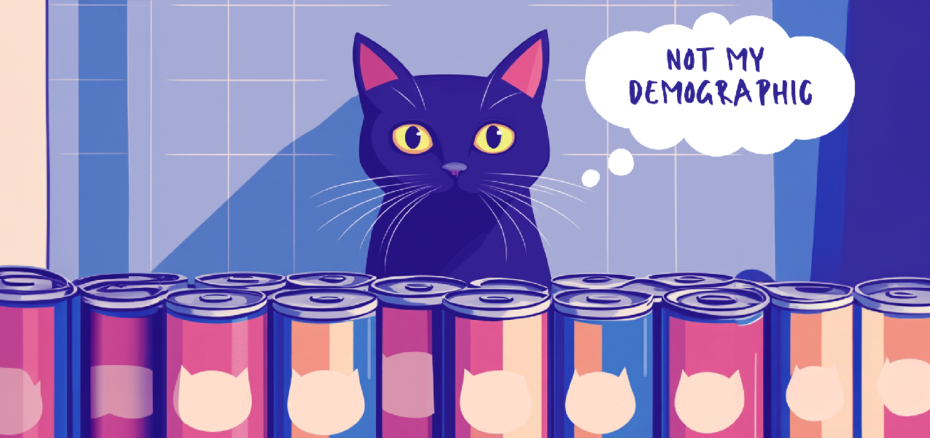Ford owners are from Mars, Chevy owners are … also from Mars

Source: Midjourney + SRH
Are your customers different?
Back in 1959, a business professor named Franklin B. Evans and his team at the University of Hawaii gave personality tests to a group of Ford owners and a group of Chevy owners.
Everyone expected the tests would reveal meaningful personality differences between the two groups.
The thinking went something like this:
People are different.
Chevy and Ford are different; each company has a unique brand image.
Cars reflect something unique about their owners.
Therefore, the people who choose Ford must be meaningfully different from the people who choose Chevy.
We’ll develop specific messaging for potential Ford and Chevy buyers based on their different personalities.
Profit!
So what did the study find?
According to Chapter 5 of How Brands Grow, “The personality and demographic profiles of Ford and Chevrolet owners were essentially identical.”
So there were no meaningful differences at all. Marketers and automobile executives were stunned.
Byron Sharp writes, “At first people argued about the results. The finding was repeatedly confirmed with different samples, techniques and product categories. After that everyone decided to ignore the discovery.” Emphasis ours.
Since then, dozens of studies have examined hundreds of brands across dozens of categories using hundreds of variables like demographics, behavioral, psychographics, values, media habits, etc.
Researchers keep finding the same three things:
Competing brands sell to the same sorts of people.
There is variation within each brand’s customer base.
Each brand has the same kind of variation.
And this is true for brands across categories — from cars to car insurance to credit cards to cat food.
Who is your real audience?
Let’s say you’re the CMO of a cat food company. There are roughly 46.5 million households with at least one cat, so it’s a fairly big market.
You can position your brand of cat food however you want — natural, gourmet, gourmet-yet-affordable, for finicky eaters, meow-inducing, scientifically formulated, etc.
Now let’s talk about segmentation.
Let’s say you don’t have the budget to reach everyone. That’s fine. Even Coca-Cola doesn’t have the budget to reach everyone.
Of course, their everyone (people around the world who enjoy beverages) is much larger than your everyone (people in the US who have a pet cat). Regardless, you have to make some choices.
How can we start creating audience segments? What do we know about pet parents?
They have various levels of income and education. Some are just starting out. Some have young kids. Some are retired. Some own their own homes. Some rent. They live all over the country. They’re people of all ethnicities, backgrounds, political persuasions, genders and walks of life.
They’re everybody. Well, they’re everybody who has a pet cat … and anyone who might have a pet cat at some point in the future.
Regardless of any psychographic, demographic or behavioral variable you can come up with, most people want their cats to live long, happy, healthy lives.
So it seems a little silly to divide the audience into segments based on age, income, lifestyle, music preferences, hobbies, their go-to allergy medication, favorite lint roller, whether they also own a dog … and so on.
Because it’s about reaching as many people as possible to sell as much cat food as you can with the healthiest margins possible so you can grow profit and market share.

Source: Midjourney + SRH
This isn’t to say market segments don’t exist. They do.
Luxury goods, for example, have fewer lower-income buyers. Most healthy people under the age of 65 don’t buy a lot of durable medical equipment.
But digital platforms make it so tempting to get wildly granular. Tell Meta to optimize for conversion, and the algorithm will find the people who are most likely to buy.
And it works … at first.
Eventually it becomes more difficult and increasingly expensive to find those buyers. So optimizing for reach becomes a much better option.
And as we’ve seen before, light buyers are incredibly valuable.
Byron Sharp put it this way: “There isn’t a vanilla ice-cream buyer and a different type of person who buys strawberry — there are just ice-cream buyers who sometimes buy vanilla and very occasionally buy strawberry.”

Source: Midjourney + SRH
And when you put people into increasingly Byzantine buckets — whether it’s through hypersegmentation or oddly specific buyer personas — you’re also deciding who shouldn’t be your customer.
Men drink Diet Coke and wear Lululemon. Women drive Jeeps and drink Miller Genuine Draft. Anyone can be a cat parent … unless they’re deathly allergic, live somewhere that doesn’t allow pets, or just don’t want to. Let them figure that out.
Your brand may have a larger audience than you’re aiming for.
Next week we’ll be paying attention to attention.
See you then.
Source!
Chapter 5 of “How Brands Grow” by Byron Sharp

